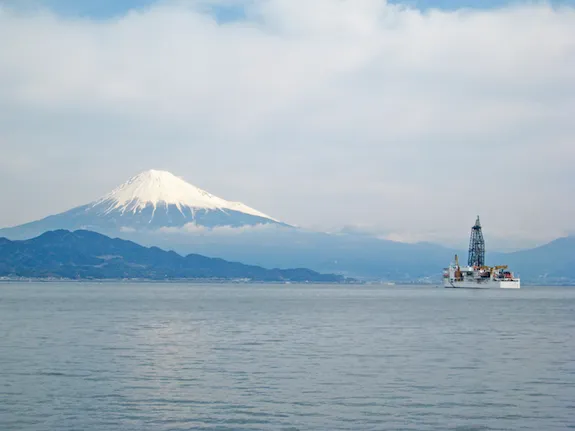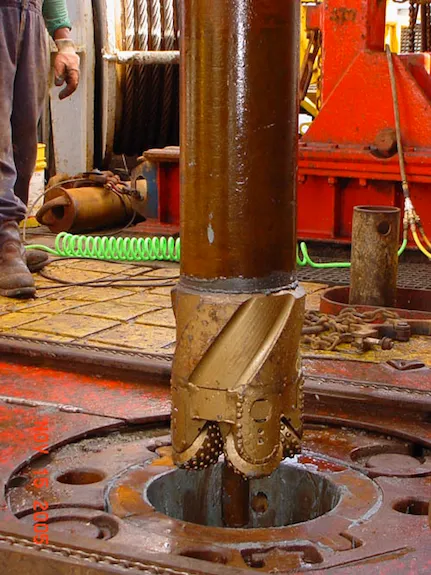New Project Aims to Drill to the Earth’s Mantle, 3.7 Miles Down
Scientists aim to reach the mantle and bring back rock samples for the first time in human history
/https://tf-cmsv2-smithsonianmag-media.s3.amazonaws.com/filer/Drill-bits-close-up-hero.jpg)
One of the strangest facets of modern exploration is that we now have more experience with the surface of Mars than the layer of earth not too far beneath our feet. Nearly everything we know about the mantle—the 1,800-mile-thick semi-molten layer of the planet below the crust—comes indirectly: from computer simulations, mantle-derived rocks that made their way to the surface and observation of earthquake waves that move through the mantle.
The international group of scientists that makes up the Integrated Ocean Drilling Program (IODP), though, hopes that will soon change. As part of a new project, they are planning to drill some 3.7 miles down into the earth beneath the Pacific Ocean to reach the mantle—and bring up samples of mantle rock for the first time in human history. Damon Teagle, a geochemist at the University of Southampton in England and one of the project’s leaders, told CNN that it will be “the most challenging endeavor in the history of earth science.”
The first effort to drill through the crust to the mantle, Project Mohole, reached 600 feet below the sea floor off Mexico before being abandoned in 1966. Subsequent attempts have gone increasingly deeper, and on September 6, the IODP’s drilling vessel, the Chikyu, set a world record by drilling almost 7,000 feet below the seafloor off Japan and bringing up rock samples.

The ambitious new project aims to go nearly three times as deep. IODP scientists have selected three different sites in the Pacific where the crust is thinnest–it was formed relatively quickly at spreading mid-ocean ridges, where new crust crystallizes as the plates move apart. Although drilling from a floating ship out at sea presents many difficulties, going through the oceanic plates that make up the seafloor is a much easier way of getting to the mantle than trying to drill through the continental plates—the ocean crust ranges from four to six miles thick, whereas the continents go 20 to 30 miles down.
Still, penetrating the oceanic crust will be an unprecedented challenge. The project will cost at least $1 billion, some of which still needs to be raised, and drilling will likely take years. The equipment will be lowered down through more than a mile of water, and the stress that the tungsten carbide drill bits encounter as they grind through hard igneous seafloor rock requires that each bit needs to be replaced after just 50 to 60 hours of use.

The extreme narrowness of the hole itself (just 11 inches wide) also increases the difficulty of the operation. “It will be the equivalent of dangling a steel string the width of a human hair in the deep end of a swimming pool and inserting it into a thimble 1/10 mm wide on the bottom, and then drilling a few meters into the foundations,” Teagle said.
As the drill descends, the team will repeatedly retrieve rock cores roughly three inches across and 30 feet long for scientists to study. If the mission is successful in reaching all the way to the mantle, the scientific payoff will be significant, as samples of mantle rock will help geologists better understand the layer that makes up more than 84 percent of the planet’s volume. “ is the engine that drives how our planet works and why we have earthquakes and volcanoes and continents,” Teagle said. “We have the textbook cartoons, but detailed knowledge is lacking.”
For Teagle and others, the mission also represents the kind of ambitious, grand project that can inspire generations of young people to get involved in science—like NASA’s Apollo missions and the more recent Curiosity rover. Teagle says that successfully reaching the mantle would be revolutionary and that it will leave a new “legacy of fundamental scientific knowledge.”
/https://tf-cmsv2-smithsonianmag-media.s3.amazonaws.com/accounts/headshot/joseph-stromberg-240.jpg)
/https://tf-cmsv2-smithsonianmag-media.s3.amazonaws.com/accounts/headshot/joseph-stromberg-240.jpg)